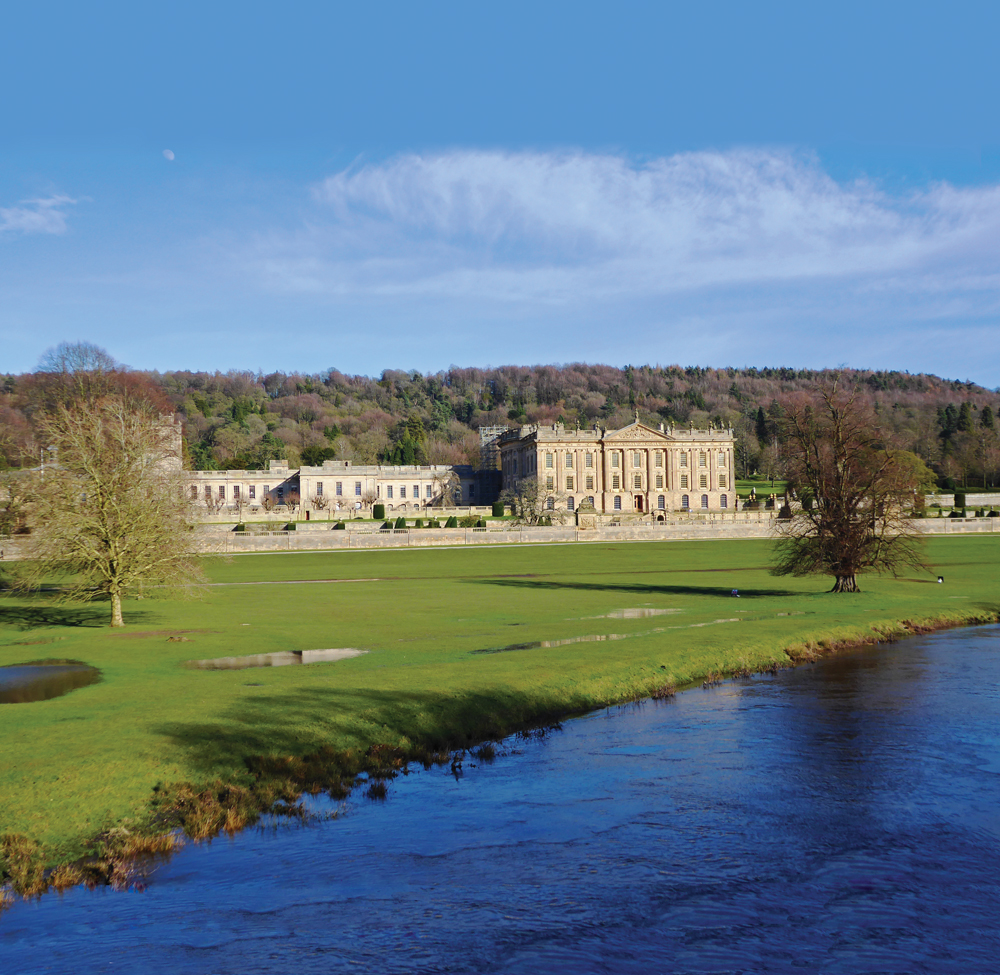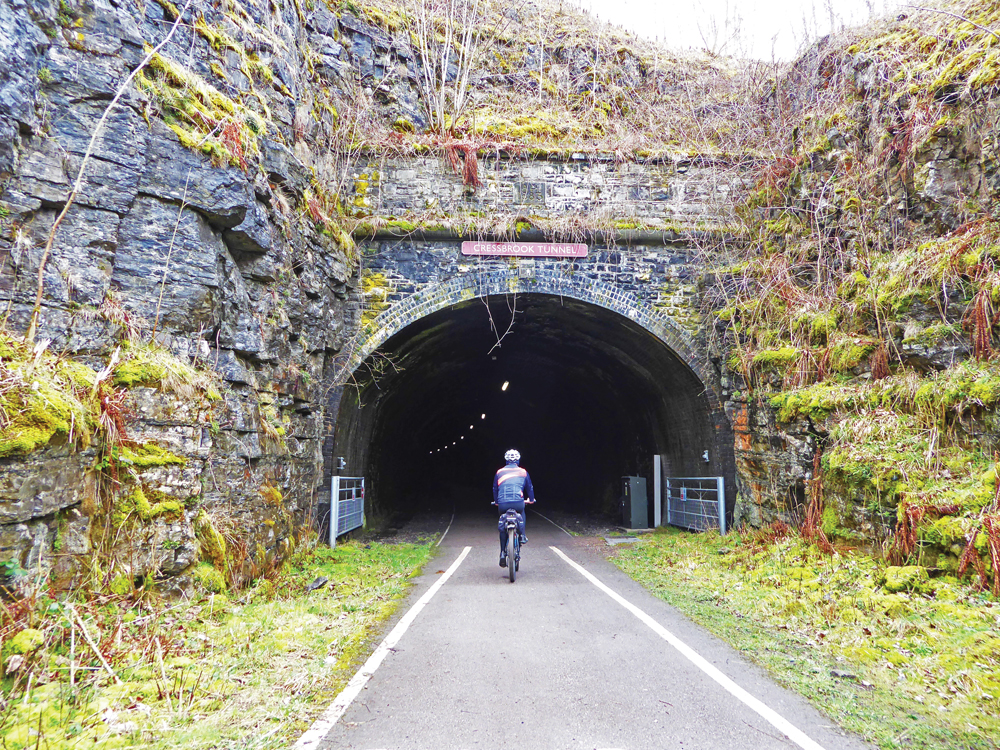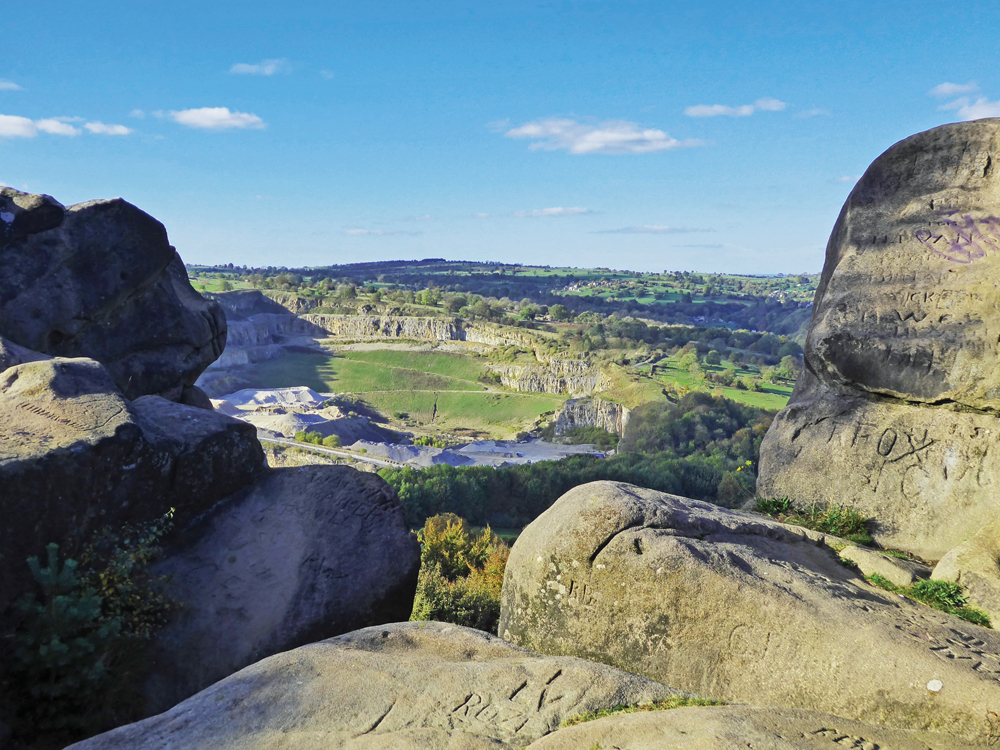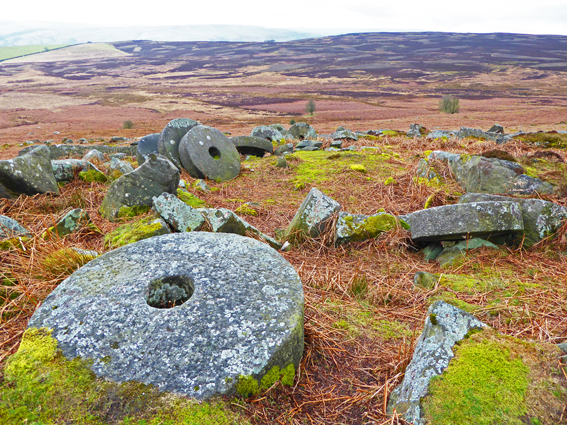Motorhome Short Break: Peak District
Words and photos: Carol Legge
This is a beautiful and versatile area to satisfy the interests of all visitors. Motorhomers can explore the Peaks, walk the trails and wander picturesque villages – Derbyshire dishes up a great short break.
If you're planning a visit, read on to discover our recommended itinerary, which allows you to see the very best of the Peak District over a few days.
Day 1: Chatsworth House and Baslow Edge
 It was like The Secret Garden in reverse. The Caravan and Motorhome Club’s Chatsworth site is in a walled garden and, in the wall, is a locked door to which we’d been given a key. Stepping through the doorway, we’d escaped from the site and into the bright grandeur of the Chatsworth Estate. We followed the peacock-blue Derwent to the great house while, across the river, young play-rutting deer clashed antlers.
It was like The Secret Garden in reverse. The Caravan and Motorhome Club’s Chatsworth site is in a walled garden and, in the wall, is a locked door to which we’d been given a key. Stepping through the doorway, we’d escaped from the site and into the bright grandeur of the Chatsworth Estate. We followed the peacock-blue Derwent to the great house while, across the river, young play-rutting deer clashed antlers.
The house was closed during our visit, but its Carriage House Café in a stable block was serving sticky wedges of cake, calories for our steep climb up to the hunting tower overlooking the estate. This tower was built in 1582 for Bess of Hardwick, the second-richest woman in England after Queen Elizabeth I and from whom Chatsworth’s Duke of Devonshire is descended.
Back in the valley, Chatsworth House glittered with gold leaf in the sunlight. The fourth Duke of Devonshire complained that the close-by estate village of Edensor ruined his view, so he had the houses demolished and rebuilt over the hill and out of sight!
Every house in the lovely walled village of Edensor displays a different architectural style, though the paintwork is a uniform ‘Chatsworth blue’. Edensor is dominated by St Peter’s Church, where JF Kennedy’s sister, Kathleen, is buried in the churchyard (having married into the Devonshire family). Opposite the church, the steamy windows of the Edensor Tea Cottage drew us in for more cake.
We walked through the estate to Baslow and up a steep track on to Baslow Edge – one of the many ‘Edges’ in the Peak District that mark a geological transition between White Peak and Dark Peak. Travelling from one to the other is like entering another world. The velvety hills and heady limestone gorges of the White Peak end abruptly at the Edges in moody millstone-grit cliffs, beyond which is a desolate upland plateau of heather and cotton-grass bog.
On the bristly heather moorland above Baslow, there is a massive gritstone monolith: the Eagle Stone. According to old custom, men of Baslow had to prove their fitness for marriage by scaling this awkward stone unaided. As we passed by, a young man was being given a leg-up by his impatient girlfriend.
The northern horizon is dominated by the steely crescent of Curbar and Froggatt Edges – colossal cliffs topped by towers of eroded gritstone slabs. Our path dropped down to a winding road before climbing a sharp bank onto Curbar Edge. A track of coarse sand safely skirts the precipice, but to take this would be to miss the exhilaration of leaping across the grippy boulders and teetering on rock overhangs. Gritstone is loved by climbers and several were scaling the rock-face along the length of the Edge.
We teetered on to Froggatt Edge, enjoying the uninterrupted vista over the Derwent Valley and hearing the calls of red grouse. They rose from the moor on a whirr of wings, garbling ‘Go back! Go back!’
We did go back, descending through birch woodland to Froggatt, from where we followed a riverside path along the Derwent across wetlands and past an old mill to Calver. Here, we discovered another tearoom. This had been a truly excellent day for sampling home-made cake!
Day 2: On the Monsal Trail
 The Peak District – described as the lungs of the industrial north – has not been unscarred by industry. The nineteenth century brought railways through the hills, carrying coal, limestone and tourists. After the Beeching cuts, several lines were acquired by the Peak District Authority to serve as recreational trails for walkers, horse-riders and cyclists.
The Peak District – described as the lungs of the industrial north – has not been unscarred by industry. The nineteenth century brought railways through the hills, carrying coal, limestone and tourists. After the Beeching cuts, several lines were acquired by the Peak District Authority to serve as recreational trails for walkers, horse-riders and cyclists.
The Monsal Trail (the former Midland Railway) begins at Bakewell. We were happy to join this level track after a vicious climb out of Pilsley across Chatsworth territory. The trail runs for 8½ miles towards Buxton and, after a couple of miles, we reached the old station at Hassop, which is now a café, gift shop and cycle hire centre.
The next station along the line is Great Longstone (now in private ownership). Alongside this is Thornbridge Hall, a listed Jacobean mansion with gardens open to the public. The trail then becomes more dramatic, passing through Headstone Tunnel (the first of six), dimly lit and dripping for its 533-yard length.
On the other side, we crossed the enchanting Monsal Dale on the Headstone Viaduct, the building of which caused controversy in 1863. John Ruskin, the Victorian writer, artist, critic and social reformer, complained, “The valley is gone … and now, every fool in Buxton can be in Bakewell in half an hour.” Ironically, the viaduct now has a preservation order on it.
We weaved through Millers Dale, a deep limestone gorge carved by the River Wye and passed high above Cressbrook Mill – one of Sir Richard Arkwright’s mills where cotton was spun for lace – which ceased production in 1965.
After Litton Tunnel is Litton Mill, which once profited by the cruel labour of young orphans taken from overcrowded London workhouses. Many were worked to death and lie locally in unmarked graves.
Disused lime kilns and quarries line the route on the approach to the two tunnels through Chee Dale near the end of the trail. Nature is slowly softening the scars of history along this now tranquil track, so it was disappointing to end our quiet railway journey in traffic on the A6 to Buxton. Our legs were disappointed, too, by the steep hill out of town after a cake stop. But we endured the ups and enjoyed the downs as we traversed the beautiful green waves of White Peak from Buxton to Baslow.
Day 3: Tissington and High Peak Trails
 Trail-riding is addictive. The following day we parked at Parsley Hay Station (junction of the Tissington and High Peak Trails), with its refreshment kiosk and cycle hire centre. The 13-mile-long Tissington Trail was the first railway to be converted and is the track-bed of the Buxton to Ashbourne line.
Trail-riding is addictive. The following day we parked at Parsley Hay Station (junction of the Tissington and High Peak Trails), with its refreshment kiosk and cycle hire centre. The 13-mile-long Tissington Trail was the first railway to be converted and is the track-bed of the Buxton to Ashbourne line.
Leaving the station, the trail threads through a deep cutting in the hillside before passing Hartington signal box, now a small visitor centre.
A high embankment carried us across a broad, grassy panorama, soaring past lyrical lark meadows freckled with sheep.
We travelled over bridges and through more cuttings to Tissington, where we left the railway and rode into the village past the Jacobean Tissington Hall, home of the FitzHerbert family since 1609. This pretty village has a pond and five wells; no one goes thirsty here. The tearoom beside Tissington Hall was where we slaked our own thirsts and sat eating cake in warm sunshine with the participants of a classic car rally. We then rode back to Parsley Hay and forked onto the High Peak Trail.
This 17-mile track meanders around magnificent valleys, alongside lime quarries and farmland, through short tunnels and past Harboro Rocks, a dolomitic limestone outcrop worth a visit for its cave that shows evidence of occupation since the Ice Age.
The railway was built in 1831 to carry goods between the Cromford and Peak Forest Canals and was operated by horses tugging the wagons on flat sections and winding engines pulling them up several steep inclines. We whistled through Hopton Tunnel and whizzed down the first of the inclines to Middleton Top, where there is an old wagon and an engine house (the oldest working one of its kind in the world).
A one-in-eight incline rushed us rattling from Middleton Top to Black Rocks, a weathered gritstone outcrop high above the Derwent Valley. Leaving our bikes, we climbed up the rocks for a superb view towards Cromford, home of the world’s first water-powered cotton spinning mill (now a UNESCO World Heritage Site).
The trail, with its expansive views, winds around the base of the rocks to Sheep Pasture, where there is another engine house above a giddy incline down to High Peak Junction and journey’s end. At High Peak Junction there are some interesting railway workshops and another café offering delicious cake.
Final Day: Stanage Edge

It was a grizzly day when we chose to visit one of the Peak District’s iconic landmarks – Stanage Edge – the largest gritstone edge at 3½ miles long. We parked on Millstone Edge above Hathersage and walked two miles across Hathersage Moor towards the sombre grey Stanage cliffs.
A short scramble took us to the top of the Edge, where we were again between two worlds. Gusts of raw mizzle pestered us. Though misty, the vista across the Hope Valley to Mam Tor, known as ‘the shivering mountain’, was majestic. Below us we could see North Lees Hall, Charlotte Brontë’s inspiration for Thornfield Hall in Jane Eyre and a location for the 2005 film Pride & Prejudice. The same film spotlighted a windswept Keira Knightley playing Elizabeth Bennet, standing in contemplation aloft Stanage Edge.
For centuries Dark Peak was quarried for its coarse stone, used in the corn and textile mills. On Moscar Moor, below the Edge, scores of abandoned millstones now lie where they were cut and shaped. Gritstone turned flour grey and, when white bread became fashionable in the mid-eighteenth century, imported quartz millstones from France caused the industry to collapse.
Never mind the bread, though, bring your own cake; there are no tearooms here!
Useful information on the Peak District
- Bikes, including electric bikes, children’s bikes and child buggies, can all be hired from centres along the trails
- Chatsworth House Caravan and Motorhome Club site is open all year
- Park your motorhome for the day at Parsley Hay (fee payable) Car Park for the Tissington and High Peak trails. Postcode SK17 0BD. Run by the Peak District National Park, which states "None of our car parks have height restriction barriers in place and are therefore suitable for small to medium sized motorhomes. Sorry, Bakewell Station is not suitable for motor homes. Overnight parking at all of our car parks is prohibited."
- Use Surprise View car park for Millstone Edge (postcode S32 1DA). Fee payable. Also run by the Peak District National Park.









Recent Updates
Engine management lights: all you need to know
What is the engine management light? What does it mean, and what do I have to do? ...
Motorhome air suspension: all you need to know
Motorhomes are heavy and the additional weight of equipment and height of the bodywork can increase the loads ...
Motorhome WiFi: how to get better motorhome internet
Staying connected on the move is more and more essential, so relying on campsite WiFi isn't an option – here ...
A class of their own - our guide to A-class motorhomes
Thinking of trading up to an A-class, or even going straight to the top of the motorhome tree? We guide you ...
Explore overseas on a motorhome dream tour
Enjoy exotic travel in a campervan or motorhome by hiring, swapping with someone else or exporting your ...
Motorhome water systems: everything you need to know
On-board water is an important part of every motorhome – here’s everything you need to know ...
Campervanning in Europe: what you need to know
Whether you're planning a leisurely drive through the French countryside, navigating bustling city streets in ...
Campervan security: all you need to know
With thefts on the increase, it’s important to know how to keep your campervan secure and prevent campervan ...
Campervan furniture: everything you need to know
Our campervan experts guide you through all the essentials for your campervan, including tables, chairs, ...
Campervan finance: how to fund your purchase
Here we look at the different types of campervan finance available, to help you decide what’s the best option ...
Other Articles
Britain’s best used motorhomes
Want a great motorhome without paying the premium for a new one? Here's a guide to the best you can get in the pre-owned market for each layout, ...
Which motorhome? Choosing the perfect motorhome for you
Choosing a motorhome or campervan is one of the biggest buying decisions you’ll ever make, so it's important ...
Campervan washroom essentials: stay fresh on the road
Our guide will take you through the campervan washroom essentials you'll need so you're well-prepared for ...
Dogs in campervans: all you need to know
Follow our advice and your dog will enjoy campervanning as much as you do ...
Electric campervans: all you need to know
Our guide will take you through everything you need to know about electric campervans and what the future ...
Motorhome electrics: a complete guide to your motorhome electrical set-up
Motorhome electrics can dramatically enhance the convenience and comfort of your vehicle – but they can be ...
Lighting for campervans: all you need to know
We guide you through all the lighting options available for you and your campervan, including interior ...
Electric bikes for motorhomes: our ultimate guide
Read our comprehensive guide to electric bikes for motorhome owners, helping you add electric power to your ...
Our guide to 'cheap' motorhomes in 2024
If you're on the hunt for an affordable new motorhome, this is the best place to start – we've rounded up a ...
Campervans in winter: all you need to know
Here's your guide to preparing your campervan for the colder months, whether you will be using it or putting ...